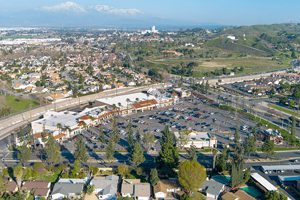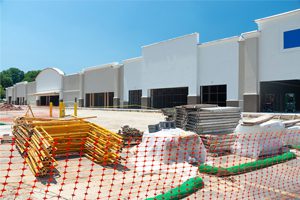Retail: A Strong Asset Class in 2024
Just a few short years ago, the demise of brick-and-mortar retail seemed imminent as consumers embraced online shopping during the pandemic. Fast-forward to 2024, and the asset class is one of commercial real estate’s strongest performers.

Despite the steady growth in e-commerce — up from 11.9% of total retail sales pre-pandemic to 15.6% at the close of 2023 — U.S. store openings outpaced closings for the second straight year. Major retailers closed 4,913 stores but also opened 5,645, up 4.7% annually, a significant turnaround from the 12,200 U.S. store closures in 2020. The leader in closures last year was Bed Bath & Beyond, with 896 stores, while drugstores CVS, Rite-Aid, and Walgreens combined for another 600. The store openings were driven primarily by off-price retailers, discounters, dollar stores, and warehouse clubs.
Nationally, the vacancy rate was in the 4%–4.6% range (depending on your source) — the lowest level since 2007. Rents continued to rise in 2023 but at a slower rate than in 2022. The lack of new retail construction due to high interest rates and elevated construction costs will keep availability rates low for 2024.

Like all asset classes, investment sales for retail tailed off considerably in 2023 to approximately $57.5 billion for the year, down 37% year over year, according to one national brokerage firm. Despite the slowdown, retail outperformed most CRE sectors. Grocery-anchored centers accounted for nearly 20% of total retail transaction volume in 2023 and are expected to remain in high demand. Private capital remains the dominant investor in retail, with 85% of acquisitions (by volume) going to non-institutional investors nationally.
One positive indicator for retail is the increase in consumer sentiment (University of Michigan index). Driven by easing inflation and increasing wage growth, consumer sentiment increased 21.4% from Q4 2022 to Q4 2023, which should translate into increased consumer spending.
According to Ermengarde Jabir, Senior Economist at Moody’s Analytics, the outlook for retail assets is strong. “Retail will emerge as the stalwart in 2024,” Jabir said. “The asset class is expected to experience steady performance, with unchanging vacancy rates and moderately positive rent growth for neighborhood and community shopping centers.”
Southern California Retail
Retail continues to perform well throughout the Southern California markets, although some are faring better than others. Los Angeles County has seen an uptick in vacancy to over 6%, while San Diego and Orange County vacancies declined and remain under 4%. Despite the increase in vacancy in LA, asking rates remain higher ($2.73 NNN) than San Diego ($2.39) and Orange County ($2.59).

Despite a decline in transaction volume from 2022, investors haven’t dropped out altogether. Vacant big-box sites with freeway access are driving sales activity in some markets — although some of those acquisitions may be redeveloped as mixed-use or multifamily in housing-constrained markets. One such deal was the acquisition of the 1.1 MSF Westfield Mission Valley mall in a San Diego suburb, acquired for $290 million by a pair of developers (Los Angeles-based Lowe and Colorado’s Real Capital Solutions) who intend to transition the property into “a walkable, livable, mixed-use community.” The average price per square foot for retail properties across Southern California was reported at $276 PSF through Q3 2023 by one international brokerage firm tracking investment sales.
There was also 2.7 MSF of retail construction underway throughout Southern California through Q3, with nearly half of it (nearly 1.3 MSF) being built in Los Angeles and an additional 882,000 SF in the Inland Empire.
Spotlight on San Diego
Voit has offices in six locations servicing the real estate needs of the Inland Empire, Orange County, Los Angeles, Mid Counties, and San Diego. For this post, we are taking a deeper dive into the San Diego retail market with the help of Mark Caston, SVP/Partner, and Max Stone, CCIM, VP, of the Voit San Diego office.
The Numbers
The Q4 vacancy (3.83%) and availability (4.30%) rates are virtually unchanged from Q4 2023 (3.93% and 4.23%, respectively), with a less than 4% increase in asking rates ($3.93 in 2024 vs. $3.83 in 2022). Sales and leasing transaction volumes were nearly even from year to year (1,117,783 in Q4 2023 vs. 1,124,126 in Q4 2022) as well. The retail market finished 2023 with 33,255 SF of positive net absorption. This equates to a 0.03% change in the total retail tenant footprint in San Diego County, following 1.2 MSF of positive net absorption in 2022 as the retail market emerged from COVID.

“The San Diego retail market is tight right now, with very low vacancy, and it doesn’t look like we’re going to see that change too dramatically one way or the other in 2024,” says Caston. “The retail space in the marketplace will be limited because of zoning changes and repositioning, as the land has become more valuable for multifamily, which subtracts from the retail inventory.”
Last spring, developer Trammell Crow Residential broke ground on a 531-unit apartment complex in Kearny Mesa (San Diego’s second-largest employment center) at a former Dixieline Lumber site. An additional 3,000 units are under review for the Convoy neighborhood, just one piece of the City of San Diego’s plan to transform Kearny Mesa from a business-focused area into a community. The plan is to eventually add 26,000 new homes, per the updated Kearny Mesa Community Plan. “When you take a sub-market like that, and you demolish 700,000–800,000 feet of retail that will not be replaced, then tenants are going to have difficulty finding alternatives, especially in a market that already has sub-four vacancy.” Because of the tight market, landlords have a clear advantage in the renewal process. However, Caston says that rents are not being pushed too aggressively because “business is still a challenge for many of the tenants.”
San Diego Investment Sales
The 2023 sales volume for retail assets in San Diego totaled $1.1 billion, including the aforementioned Westfield Mission Valley Mall and the 1.2 MSF North County Mall in Escondido, which sold for $57 million. French company Unibail-Rodamco-Westfield sold both, but unlike Westfield Valley, which is being repurposed for mixed-use, North County Fair’s new owners will invest in upgrades and retain the property as a mall.

In addition to the continued high interest rates, there is still a wide gap between the bid versus ask for assets. Property owners are in no hurry to sell, particularly with properties that are well-located with national tenants and little to no vacancy, says Stone. One product type that he says is seeing escalating rents and increasing demand by investors is drive-through properties “especially in urban infill areas.” Drive-throughs became a necessity during the pandemic, but consumer behavior evolved, and drive-through tenants realized their business was sustainable and that it could grow,” says Caston.
In 2024, we predict the overall retail property inventory in San Diego will continue to contract for the near term due in part to repurposing retail properties into multifamily housing. Vacancy levels should remain low through 2024, and high interest rates will impede the property sales market, at least until the Fed makes good on the anticipated rate cuts.
For a more detailed assessment of the San Diego retail market, read the Voit 2023 Q4 San Diego Retail Market Report or click here to download the report. Visit the Voit Services page for additional information about sales and leasing retail properties in Southern California.









